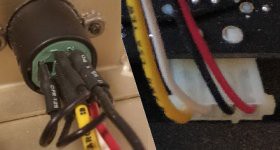# 2022-08-22 First look
I've taken the thing apart, mostly in order to clean it and identify its components. I had a bit of trouble getting the jog wheel off, as it's fastened to the rotary encoder by two deep-set 1/16th-inch hex screws -- and nearly all my tools are metric. I got it off, but now it's not very tightly affixed. No matter.

Wowza, that thing is solidly built! The enclosure is bult of 4mm aluminium sheet that seems to have been either laser cut or machined; the way that the blue-tinted plastic sheet covering the display is recessed from the inside makes me think at least that opening was machined, so probably the entire thing. The sides are solid 10mm aluminium that've been machined to mate with, and welded to, the edges of the sheet metal. Also welded to the enclosure are a significant number of stand-offs for the circuit boards as well as the trackball brackets which also has mounting screws flush welded to them. The plate covering the bottom and back is 2mm aluminium sheet with ventilation louvres. To this plate an angled recess has been welded which holds the sockets for power and communication.
While I had the enclosure stripped of its components, it occurred to me that I could take the opportunity to give it a new paint job. But nah, I'm going to keep the original look to retain the Accom and Axial logos, in spite of the scratches (err, I mean, to preserve its patina).
As for the guts, there are four separate boards:

- (lower left) keyboard, numpad and surrounding keys,
- (lower right) jog/shuttle wheel buttons,
- (upper left) function clusters,
- (upper right) display, knobs and dials (main board, with power, comms, and CPU),
tied together by a 34-line ribbon cable.
The circuit boards are all double-sided, single-layer, and obviously bespoke; curiously, some are dated 1991 and some 1994. Thankfully, the components are regular off-the-shelf items, which makes it easy to obtain datasheets:
- most of the keys use Cherry MX Black switches, though the lighted ones use something else yet to be identified;
- the trackball is a 50mm Disc Instruments LQ200-192-50 which, according to the datasheet, supports up to three button inputs as well;
- the jog/shuttle wheel is backed by an HP HEDS-5701-I02 rotary encoder;
- the character display is a stock NEC FC40X2EA-AB VFD daughter board;
- the dial knobs are backed by Avago HRPG rotary encoders.


Main power was delivered through a 6-pin XLR socket on the rear, internally wired to a Molex connector.
 noughtnaut
noughtnaut
Discussions
Become a Hackaday.io Member
Create an account to leave a comment. Already have an account? Log In.
"solid 10mm aluminium" -- Why so massive; is this meant to be used in a war zone?
Are you sure? yes | no